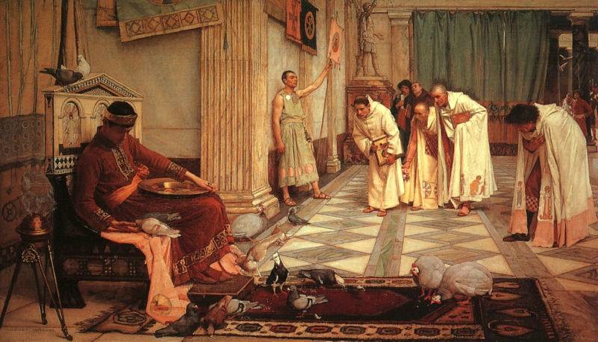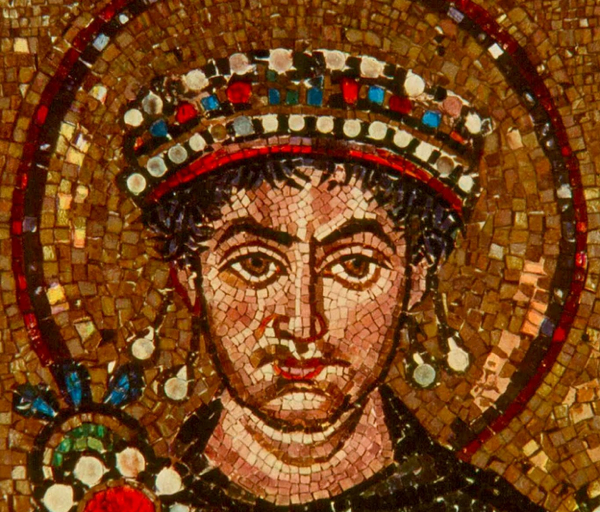The Byzantine Empire existed
for nearly 1,125 years, and it’s one of the greatest empires of all time. Yet
many people know little about it, other than the word “byzantine” being
synonymous for highly intricate, complex, and devious dealings.
Beginning its adult
life as the capital for the Eastern part of the Roman Empire, the city of
Constantinople—later Byzantium, and Istanbul today—became the center of an
extremely vibrant society that preserved Greek and Roman traditions while much
of Western Europe slipped into the Dark Ages. The Byzantine Empire
protected Western Europe’s legacy until barbarism waned, when finally the
preserved Greek and Roman masterworks opened the eyes of Europeans and stoked
the fires of the Renaissance.
Many historians have
agreed that without Byzantium to protect it, Europe would have
been overrun by the tide of Islamic invaders. The purpose of this
list is for the readers to take an accurate historical journey—based on real
facts—very much worth taking.
1.Origin of the
Empire’s Name

The origins of
Byzantium are clouded by mystery, but for our list we will follow the generally
accepted version. Around 660 B.C., a Greek citizen, Byzas, from the town of Megara near
Athens, consulted the oracle of Apollo at Delphi. Byzas requested advice on
where he should found a new colony, since the mainland of Greece was becoming
overpopulated. The oracle simply whispered, “opposite the blind.”
Byzas didn’t
understand the message, but he sailed northeast across the Aegean Sea. When he
came to the Bosphorus Strait, he realized what the oracle must have meant.
Seeing the Greek city of Chalcedon,
he thought that its founders must have been blind, because they had not seen
the obviously superior site just half a mile away on the other side of the
strait. So
he founded his settlement on the better site, and called it Byzantium after himself.
he founded his settlement on the better site, and called it Byzantium after himself.
2.Geopolitics Favored
Byzantium

Byzantium had an
excellent harbor and many good fishing spots in its vicinity. It occupied
a strategic position between
the Black Sea and the Mediterranean Sea, and therefore soon became a leading
port and trade center, linking the continents of Europe and Asia. Occupation,
destruction and regeneration became the rule for the city.
In 590 B.C., Byzantium
was destroyed by the Persians. It was later rebuilt by the Spartans, and then
fought over by Athens and Sparta until 336 B.C. From 336 to 323 B.C., it was
under the control of the famous Greek general, Alexander the Great.
After the death of Alexander, Byzantium finally regained its independence.
In the following
years, right before the city became the capital of one of the greatest empires
ever, it was attacked by various invaders such as the Scythians, the Celts, and
of course the Romans.
3.The Byzantine
Empire Is Born

In A.D. 324 the
Emperor of the West, Constantine I,
defeated the Emperors of the East, Maxentius and Licinius, in the civil wars of the
Tetrarchy. Constantine became the first Christian emperor of the
Roman Empire—though the complete conversion of the Roman Empire to Christianity
was not accomplished during his lifetime. There’s no doubt that during the rule
of Constantine, Christianity became the dominant religion of the Empire—but
it’s very possible that Constantine’s biggest regret was that he was never able
to achieve a unified Christian Church.
The construction of
the city of Constantinople, however, was one of his absolute triumphs. While
other Ancient Greek and Roman emperors built many fine cities during their
reign, Constantinople exceeded them all in size and magnificence. It soon
became the capital of the Byzantine Empire, and thus marked the dawn of a new
era.
4.The Split of the Empire

Most historians today
have trouble deciding exactly which event or date signifies the fall of the
Roman Empire. One of the most common conclusions is that when the Empire was
split in two, it would never be able to reach its former glory again. There’s
even more debate on the religions of the age, which were probably the decisive
factor separating the Byzantine Empire from the spirit of Classical Rome.
Theodosius I was the
last emperor to rule over the whole Roman Empire. He was also the one who split
it right down the middle, giving Rome (West) to his son Honorius and
Constantinople (East) to his other son Arcadius. The more classical, Western
part of the Roman Empire weakened significantly when the land was divided,
while the Greek-influenced Eastern half continued to develop the oriental
aspects of its culture. The Roman Empire, as the world had known it, no longer
existed.
5.The Golden Era of
Justinian I

One of the most widely
known contributions of Justinian I was the reform of the laws of the Byzantine
Empire, known as “The Justinian Code.”
Under his rule the Byzantine Empire flourished and prospered in many ways.
Justinian gained power
and fame for his buildings and architecture. One of his most famous buildings
was the Hagia Sophia,
which was completed in A.D. 538. It became the center of the Greek Orthodox
Church for a number of centuries. This massive cathedral still
stands today in Istanbul, and remains one of the largest and most impressive
churches in the world.
Justinian also
encouraged music, arts, and drama. As a masterful builder himself, Justinian
commissioned new roads, bridges, aqueducts, baths, and a variety of other
public works. Justinian is considered a saint by the Eastern Orthodox Church
nowadays, even though a good amount of Orthodox Christians don’t agree with his
sanctification.
6.The Greek Element
Takes Over

Most historians agree
that after the accession to the Byzantine throne ofHeraclius in 610
A.D., the Byzantine Empire became essentially Greek in both culture and spirit.
Heraclius made Greek the official language of the Empire, and it had already
become the most widely spoken language of the Byzantine population.
The Byzantine Empire,
having had its origins in the Eastern Roman Empire, now evolved into something
new—something different from its predecessor. By 650 A.D., only a very
few lingering Roman elements remained alongside the pervasive Greek influence.
According to various historical sources, a large majority of the Byzantine
population from 650 A.D. onwards was of Greek cultural background.
Additionally, the Byzantine army fought
in a style which was much closer to that of the Ancient Athenians and Spartans
than that of the Roman Legions.
7.The Byzantine Navy
Uses Greek Fire

The Byzantine Navy was
the first to employ a terrifying liquid in naval battles. The liquid was pumped
onto enemy ships and troops through large siphons mounted on the Byzantine
ships’ prows. It would ignite upon contact with seawater, and could only be
extinguished with great difficulty.
The ingredients of “Greek fire” were closely
guarded, but historians think it was a mixture of naphtha, pitch, sulfur,
lithium, potassium, metallic sodium, calcium phosphide and a petroleum base.
Other nations eventually came up with similar version of the stuff, but the
fact that it was dangerous for their own troops, too, made it go out of
military fashion by the mid-to-late fifteenth century.
8.Byzantine Cuisine

When we hear the term
“Greco-Roman,” we automatically think of culture, architecture, philosophy, the
Olympic sport of wrestling—but not of Byzantine cuisine.
To learn about Byzantine cuisine properly,
we need to go back to its roots. It involved a mix of Greek practices and Roman
traditions. Byzantine culinary tastes focused on the regions where Hellenism
flourished: cheese, figs, eggs, olive oil, walnuts, almonds, apples, and pears,
were all staples of the Byzantine diet, indigenous to the lands of the empire
and appreciated by aristocracy and common people alike.
The Byzantines also
loved honey, and often used it in cooking as a sweetener, since sugar was not
available. Bread was an essential staple of the Byzantine table, and a
guarantee of stability for the government in Constantinople. And it was a massive
enterprise—the bakeries of Constantinople regularly producing over 80,000 loafs
per day.
The Byzantines could
count on a steady diet of bread, cheese, meat, and fish, much of it cured and
preserved in salt and olive oil. But just like in modern Greece, this diet was
supplemented with vegetables that were produced in small gardens.
Despite the limited information we have today, our knowledge of Byzantine cuisine is like the restoration of a damaged mosaic; even though a lot of the pieces are still missing, the picture still has a beautiful quality to it .
Despite the limited information we have today, our knowledge of Byzantine cuisine is like the restoration of a damaged mosaic; even though a lot of the pieces are still missing, the picture still has a beautiful quality to it .
Today, the aromas and ingredients of
Greek and other Mediterranean food gives us a little taste of what Byzantine
food must have been like.
9.Byzantium’s Economy
Was The Most Powerful In Europe

The Byzantine Empire
was mainly comprised of an array of small towns and seaports connected by a
developed infrastructure. Production was very high, and there was a notable
growth in land ownership. The Byzantines followed a Christian lifestyle which
revolved around the home, where women dedicated themselves to the upbringing of
their children. There were also various public places where men sought
relaxation in their leisure hours.
From A.D. 500 to A.D.
1200, Byzantium was the wealthiest nation in Europe and western Asia. Its
standard of living was unrivaled by other nations in Europe,
and it led much of the
world in art, science, trade, and architecture. We could even
say that the “Byzantine Dream” existed long before the American one.
10.The Great Schism

Most historians of
Byzantium agree that the Empire’s greatest and most lasting legacy was the
birth of Greek Orthodox
Christianity. Eastern Orthodoxy arose as a distinct branch of
Christianity after the “Great Schism” of the
eleventh century between Eastern and Western Christendom.
The separation was not
sudden. For centuries, there had been significant religious, cultural, and
political differences between the Eastern and Western churches. Many historians
assure us today that religion was the main reason why Roman culture lost all
its influence on the Byzantine Empire.
There were major
theological differences between Roman Catholics and Greek Orthodox Christians,
on topics such as the use of images, the nature of the Holy Spirit, and the
role (and identity) of the Pope.
Culturally, the Greek
East has always tended to be more philosophical, abstract, and mystical in its
thinking, whereas the Latin West tended towards a more pragmatic and
legal-minded approach. All these factors finally came to a head in 1054
A.D., when Pope Leo IX excommunicated the Patriarch of Constantinople, who was
the leader of the Greek Orthodox Church. In response, the Patriarch condemned
the —and nearly one thousand years later, this division in the Christian church
has still not been healed.
potatoes are yummy!!!!
ReplyDeletepotatoes are yummy!!!!
ReplyDelete